ISSN: 1550-7521
ISSN: 1550-7521
Asif Nawaz*1, Tariq Ali1, Yasir Hafeez1, Arfaa Asaf 2
1 Department of Agriculture, Pir Mehar Ali Shah Arid Agriculture University, Rawalpindi, Pakistan
2 Department of Agriculture, Shaheed Zulfikar Ali Bhutto Institute of Science and Technology, Islamabad, Pakistan
Received: 27-Apr-2020, Manuscript No. GMJ-20-9890; Editor assigned: 30-Apr-2020, PreQC No. GMJ-20-9890; Reviewed: 14-May-2020, QC No. GMJ-20-9890; Revised:03-Sep-2022, Manuscript No. GMJ-20-9890 (R); Published: 31-Oct-2022, DOI: 10.36648/1550-7521.20.56.331
Citation: Nawaz A, Ali T, Hafeez Y, Asaf A (2022) Exploring Public Opinion to Analyze the Consequences of Social Media on Students’ Behaviors Tik Tok and the possible perseverance of Cultural Imperialism. Global Media Journal, 20:5 .
Visit for more related articles at Global Media Journal
Social media such as Facebook, twitter, blogs and flicker widely used by people, not only as a medium of communication but also as source of distributing information, with the advancement of technology today. Now a days, one of the most frequently used communication methods are social networks. In various research studies, their use in different fields and the effects of social media on student's behaviors, chat sites and blogs caused by Facebook has been analyzed. With regard to the use of Facebook, positive connection with confidence, social media participation and social media related behaviors will also be assessed. In order to obtain the basic data, a general scanning model that is public opinion and views of parents and comments that are openly available across social media sites, used to perceive attitude of graduate students, instead of traditional methods like questionnaires and survey’s conduction. A dataset of nearly 20000 reviews of parents was collected from different social media networks about their children’s, while in another dataset tin which 362 graduate school teachers who observe the students to use social media during classes, labs and in campus during free times, their comments about those students were chosen. As per this study, through different positive and negative factors the detailed analysis has been performed to show effect of social media on student’s behavior.
Opinion, Students; Behavior; Social Media
As a way of entertainment, distributing information and communication, social media is widely used by people particularly graduates and undergraduate students. Their purpose of joining the social media is for "comments" and "likes" and their views that are being "shared" [1,2]. Social networks and micro blogging sites like twitter, Facebook and flicker are more famous in public as compared to other media because of their extensive usage and simple processing [3]. If we talk about different age groups, it has been clearly observed that mostly the users of social media are the youngsters. Figure 1 shows the age wise usage of social media forums. The age wise usage of social media forums. With the Passage of time they are continuously passing through the social drive and allow other people to write their views on it and put them on the social media.
Social media and social networks have dramatic influence on the student community. Precisely innovations are being provided via numerous networking websites and social media that are taking place swiftly in the field of information technology. For instance, WhatsApp, Instagram and Facebook offer some of these methods of communication that are neither instructed nor reciprocated and new-fangled social connectivity patterns of communication (Figure 1) [4].
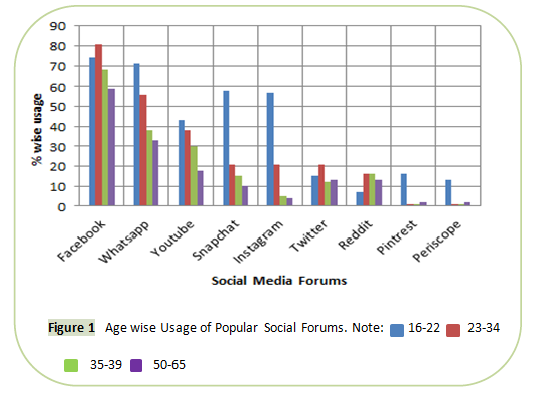
As far as social networking is concerned, it is all about social actors and their settings. Settings are at multiple levels like individuals, communities and organizations comprises of social actors and the social interactions including communication. In the inspection of culture and society, technological innovation has led in both positive and negative changes. Therefore, social media and networking sites provide both damaging and productive elements to the community and the effect of social media and social networking sites have had a major influence on students during their transition to adulthood alike to any powerful platform or improvement in innovation [5].
The presentation of the public to user-generated data, ideas and programming at a comparatively young age is one of the constructive consequences of social media usage, which has enhanced knowledge in student communities and supported additional technological improvements. However, the increased level of depression in students by dramatically altered the social environment in which students grow and learn. The complete examination of the impact of social media on students learning and its impact on students’ communities depicts in this study [6].
The study in emphasized on investigating the influence of technological innovation on students learning behavior, which plays vital role in students growth. We directed this investigation to analyze several issues relating to examples of social media usage at selected universities. Furthermore, through the comments of parents, teachers and their guardians particularly their siblings, their behaviors in society after using social media has been analyzed through very common positive and negative factors involved in social media usage [7,8].
The improvement in Internet and its approval at public level and thereafter it’s usage by common public specifically young generation and students through social media which has played a vital role in this conversion. Due to the improvements in social media and the participation in social activities has completely altered the current landscape into new proportions in the last period. Now particularly the social media has a major characteristic in the social campaigns and the way public view and grab the difficulties mentioned on this platform in details in spite of time and space constraints. Previously, most of the work on social media particularly on social network sites centered on the individual uses while some surveys have been published on the different social campaigns.
The study conducted and examining the role played by the new type of media, particularly social networks, in establishing political and social knowledge among Arab youth. The role of social networks in the development of political and social knowledge among Arab youth has been examined. On personality of the young public, the influence of the use of social media been investigated in number of researches [9]. The use of social media by different communities (Figure 2).
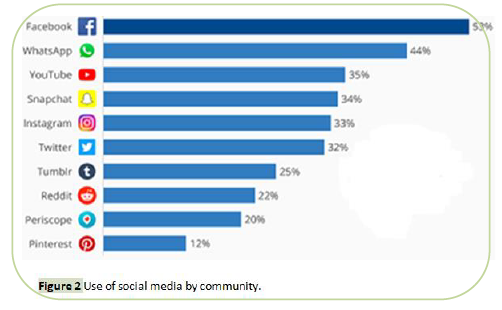
Bozkurt survey named as "University Youth Communication through Social Network Sites" described a study conducted to investigate the process of correspondence for genuine thought process through community locales among university students. It has been clearly observed from the study that the more than being a need made by current time innovation such similarity is considered as a social wonder [10]. An article "Facebook and the Technology Revolution", investigates the Facebook impact on students of university, while 219 students of the university have been included in this study showing the results about the addiction of Facebook and Internet among the students of the university with large social network [11].
The use of microblogs to promote civic participation among Chinese undergraduate and graduate students [12]. A youth open platform and video site in China, with a bulletcommenting technology can help in boosting participation culture [13]. The program in the Jane Goodall Institute’s Roots and Shoots program with a unique, service-learning approach to youth development and explored observations of the impact of the program on social development of Chinese youth along with the personal development [14]. How Chinese university students use intranet to participate in civic activities [15].
After analyzing the influence of both media tools and participant incorporation in organizational performance and monitoring for various organizational features, concluded that using media tools is not enough to increase performance since the way they are used also matters and implies that incorporation of the young generation in daily decision making methods, increases organizational performance and the relationship is vigorous by the inclusion of organizational characteristics [16].
Related research
There are many surveys conducted about the positive and negative impacts of social media on the students' academic and non-academics performances. In the survey conducted that alleged that the use of social media can be a good way out to trade with academic failures, particularly if the students having connection with another student facing the identical issue. Social media allows students to get linked with other students that can be very functional as it will permit them to talk about class matters by means of social media [17]. Furthermore, attain students’ visions of how their use of social networking sites affects their academic efficiency. The researchers conducted a preface survey of a group of Malaysian university students. It was found that the bulk of interviewees approved that social networking sites have a positive impact on their academic effectiveness [18].
Social networking has a significant outcome on the students' academic effectiveness. They also have meaningful outcome about the irregular use of social media platforms by students. The study recommended that it is helpful in universities and colleges in Malaysia to teach their students to use these platforms absolutely for educational purposes which will eventually consequence in a positive effect on their academic efficacy [19]. Students are most likely influenced by social media. To some extent, it completely influences the lives of college students including the grades. They added that social media is striking as it gives college students another world to make friends, also offers a good way to relieve pressure. It was also observed that an approach is needed to stable the connection between social media and academic study. As a result, college students should consider more about the harmonizing of social media and academics [20].
Moreover, the results of an a survey carried out along with undergraduates in Nigeria displayed that there are some advantages obtained from using social media, which supports virtual conference with co-research scholar; self-esteem and wellbeing; research and learning; escalating interpersonal connection; read and write web skills etc. It was also observed that students use social media to talk with friends, watching movies, for considering national problems like Politics, economy and religious issues and for academic purposes. There are some students practiced development in their reading skills as an outcome of contribution and linking social media. Also, respondents discussed ideas and shared inspection questions amongst themselves on social media [21].
Nevertheless, that bulk of respondent’s experienced negative effects i.e. bad grammar and spelling, delayed in submission of assignment, less study time and bad academic efficacy because of excessive use of social media networks. Furthermore, compulsion toward using social media amongst students was elevated. Some risks related to social networking sites such as E-crime, Internet addiction, laziness, typical crime like, fraud, murder, kidnapping; immoral act like, pornography, prostitution, cyber-bullying were recognized [22].
The conclusion of a survey conducted depicted that faculty and students vary to a certain extent in their current and anticipated use of social media like Facebook [23]. It was observed that there is a vital dissimilarity between the supposed roles of this tool as social, more willingly than educational. Students look like much more open to the thought of using Facebook instructionally than do faculty. The most of the faculty members assumed that social media have a negative consequence on the students' academic efficacy compared with positive impacts, due to lack of knowledge among the students and faculty members about the suitable usage of social media topics of educational curiosity. In the meantime, the positive impacts of social media on their academic efficiencies turned up to be appreciably low [24].
Carried out a study among undergraduates at Rowan University of the USA. The study explained that social media do not have a positive impact on the students' academic accomplishments, because the student’s GPA dropped as much as they were preoccupied in social media. The study recommended that undergraduate students should direct and examine their time spent using social media such as Facebook. Revealed social media as a feature in the lacking of habits of reading newspaper amongst students and it may be the reason to lose much beneficial information available in the newspaper.
Moreover, the social networking is completely affecting students’ efficiency as well as their grades. Therefore, educators need to be more concerned about these problems and tried to find better ways to solve these problems. Though, structured within an academic context, the concepts mentioned here can be used to examine the use of communication technology not only at school, at home, workplace and in more other settings and for a variety of different viewers like teenagers, young adults, the elderly or families.
Social networks impact on student’s health was defined by Khalid [26]. How academics of the students was affected by social networks influence the academics of students was discussed by him. At the end, how youngsters got composed by their personal and confidential data was discussed by him. The excessive use of social networks effects the students’ psychological and physical health negatively was also figured out by him. The influence of social media is quite positive on their academics. It has been noted in the study that there are so many students who are the victim of harassment due to the lack of knowledge about their rights. Therefore, his study recommended that as a subject or at a workshop seminar social media should be taught for the awareness.
Lack of any previous research on the apparent influence of social media on social improvement among university students motivated us to inspect the type of usage of social media, prevalence, the motivation for social media use and the impact of social media on students’ social improvement. The focal point of this study is behavior of students on social media. Gauging a positive connection between social media participation and confidence can also be doped. The disadvantages of using social media have also been explained in the research. As today's students are “digital natives” who were born with new technology and display excessive social network use. This study would be useful to emphasize student behavior on social media. The following points are highlighted in this research:
• Establishing the usage of social network among students.
• Pointing out behaviors of respondent son the Facebook
• To observe the types of social media platforms commonly used by students.
• To find out the amount of time students invested on social media.
• To examine the purposes for which students used social media.
• To investigate the perceived impact of social media use on students’ social life.
Identifying the productive and non-productive factors of social media that classically shows the effect son students’ learning behavior, this research examined the data collected in a form of opinions and reviews. Consequently, obtained within limited resource and continuous effort to search it, we also conducted an extensive examination of the earlier literature to build up an inclusive understanding of this topic. In addition, to understand the view of the student community concerning social networking sites, we established a unique data collection process that focus on considering only those opinion and review that only focus on the effect of social media on students. Before administering the process of data gathering, we adjusted the study design with their specialist opinions, without some traditional or unrelated elements, together with suitable variables in the study. The reviews and opinions are categorized on the basis of parents, teachers and Siblings who post it on social media while observing their children during different occasions.
To check the reliability and effectiveness of the gathered data and to identifying most effective factors, Standard Deviation (SD) and Mean Score (MS) for each factor has been calculated. Subsequently, to evaluate and validate the consistency of the respondents’ opinions, we employed Analysis Of Variance (ANOVA). In short, to evaluate the necessary elements affecting students’ learning behavior, major information that showed the analysis of the discoveries, could be used. By analyzing the survey discoveries and data and the experts suggested practical proposals based on the results of the study, media specialists have been occupied in the survey given their input for the poll study. The purpose of this study is to analyze the effect of social media based on open review and opinion with the support of various positive and negative factors of social media observed by early studies.
Data collection
Researchers analyze the social media manually and that is a hectic task in time perspective with so many limitations. As conventional approaches are time-consuming and permits analysts to assess only inadequate amounts of material. In addition, researchers will not be competent to understand public opinion or mood on a mass scale and their biases may influence their interpretations of what they read. As far as survey procedure is concerned, the information gathered from the questionnaire used in the survey is not much authentic. People who are filling up the survey forms are sometimes not able to provide the answer of all questions mentioned in the survey questionnaire. Thus, there is a possibility that the result after the analysis of survey questionnaire may not portray the promising results or may have the chance of ambiguous results on certain subject. So in this research, a public opinion of individuals particularly parents; teachers and entrepreneurs’ views and comments that are posted on various social media forums about their kids and students are collected. The detailed description along with review structure.
The categories of the reviews and comments showing that there are 22,450 reviews of post graduate students while the reviews posted by the parents are 42,230 in number. University teacher’s comments are 11,700 in number and last but not the least the miscellaneous reviews are 900 in total describing the detail of the dataset used. Duration of the usage of social media vs the number of respondents that have used the social media within one hour, two hours, three hours, four, five and more than five hours of interval respectively (Table 1).
| Comments/Review Category | Number of Reviews |
Source Link |
|---|---|---|
| Post Graduate Students | 22450 | https://www.postgraduateforum. com/?cat=Off https://www.findamasters.com/a dvice/masters-discussionforum.aspx |
| Parents | 42230 | https://www.kidsinthehouse.com/ forums/elementary-talk |
| University Teachers | 11700 | http://edupln.ning.com/ https://whoteaches.com/ |
| Miscellaneous | 900 | https://www.riverbankschools.org /parent-teacher-forum-ptf/ |
Table 1. Dataset
Data processing
With the consumption of Stanford Core NLP, the POS labeling and stemming are finished. Sentences for example, "this is anything but a decent teacher’s facility" consume words with positive division. However the elimination of expression of NOT alters the division of a sentence. Furthermore, unigram features don't demonstrate relations between words in the content. Before their removal the effect of the negative word must be reflected in the unigram features (Figure 3).
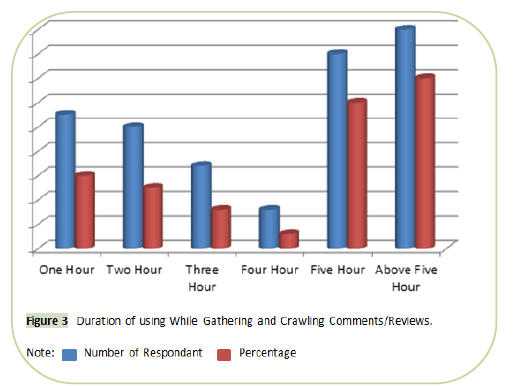
Data analysis
It’s a hectic and time consuming task to collect relevant reviews and comments from different social media platforms. However, there is a possibility of data crawling which has been utilized very diligently and carefully to observe the usage of social media by certain users in different time spans. It has clearly been observed from the figure that number of respondents on social media is increasing or decreasing on hourly basis. When data has been collected it’s not in a pruned form and may have redundant and fake information in it. The data has been pruned through the pre-processing phase. Finally, the description of the reviews in terms of vocabulary size (Table 2).
Dataset Name |
Duration | Number of Reviews | Vocabulary Size |
|---|---|---|---|
| Parents Dataset | One hour | 18903 | 8200 |
| Three hour | 15438 | 6100 | |
| Five hour | 7947 | 2725 | |
| Total | 42230 | 17025 | |
| Teachers Dataset | One hour | 7800 | 5300 |
| Three hour | 2450 | 3300 | |
| Five hour | 12200 | 9100 | |
| Total | 22450 | 17700 | |
| PG Student Dataset | One hour | 3350 | 4100 |
| Three hour | 1850 | 2450 | |
| Five hour | 6500 | 5350 | |
| Total | 11700 | 11900 |
Table 2. Data description.
As per data analysis, to discover and establish the most significant social media factors and their absolute impact on the students’ communities are the major challenges of this particular study. After an in-depth examination and each element have been investigated autonomously, these factors were acknowledged from the earlier literature (Figure 4).
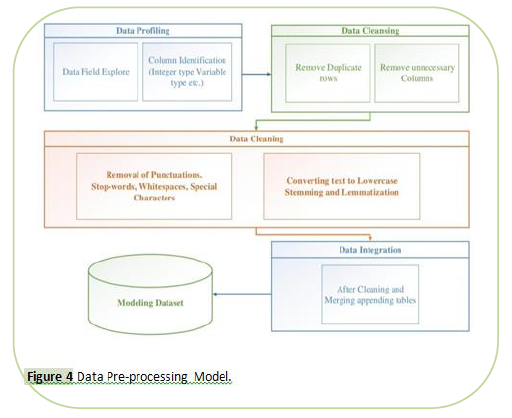
Influencing factors
The decisive challenge of this study is to analyze opinions of parents, teachers and sibling to determine the effect of social media on their students and kids. Moreover, this research work utilizes the most common factors i.e. positive and negative those are already mentioned in the past literature that influence the students to strengthen the proposed analysis (Table 3).
S. No. |
Factor ID | Positive Factor |
|---|---|---|
| 1 | PF01 | Awareness Towards Study |
| 2 | PF02 | Study Material Sharing |
| 3 | PF03 | Group Discussion |
| 4 | PF04 | Building Community |
| 5 | PF05 | Search Books and Reduce Cost of Purchasing |
| 6 | PF06 | Improve Oral and Verbal Skills |
| 7 | PF07 | Social gathering and Promoting Social Drives |
| 8 | PF08 | Strengthen Knowledge |
| 9 | PF09 | Reduce Stress |
| 10 | PF10 | Regular and Energetic |
| Negative Factors | ||
| 1 | NF01 | Time Wastage |
| 2 | NF02 | Lake of Writing and Reading Skills |
| 3 | NF03 | Laziness |
| 4 | NF04 | Lake of health Hazards |
| 5 | NF05 | Mental Depression |
| 6 | NF06 | Whistle Blowing |
| 7 | NF07 | Ethical problems while joining different Groups |
| 8 | NF08 | Mind Disruption |
| 9 | NF09 | Increase cyber-bullying |
| 10 | NF10 | Lack of Critical thinking |
Table 3. Influencing factors
The most prominent social media factors and their eventual effect on the students’ communities are the major challenges of this particular study were to investigate and verify, according to data analysis. From the earlier literature, these factors were acknowledged after an in-depth examination. The positive impact of the social media among the groups of parents, teachers and PG students along with their mean and f value.
The positive factor with PF ranging from 01 to 10 is showing the range of positive factors among the teachers, parents and PG students. While shows the positive factor’s mean and SD. The positive factors have the sharing of study material sharing, group discussion, building community, searching of books, improvement of oral and verbal skills, social gathering and promoting, strengthening of knowledge and stress reduction (Figure 5).
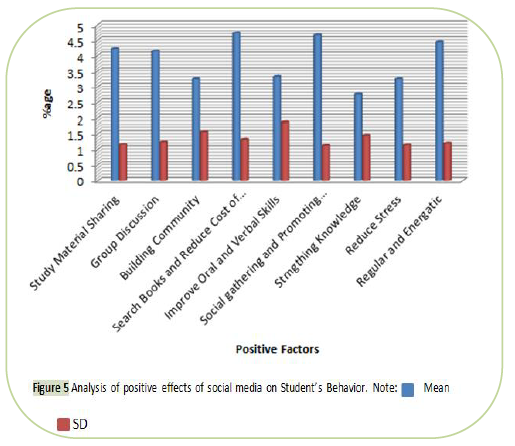
The unfavorable or negative impacts of the extreme use of social media which include the wastage of time, lack of writing and reading, laziness, lack of health hazards, mental depression, whistle blowing, ethical problems, mind disruption, cyber bullying and lack of critical thinking. The graphical bars are showing the percentage of their mean and SD (Table 4 and Figure 6).
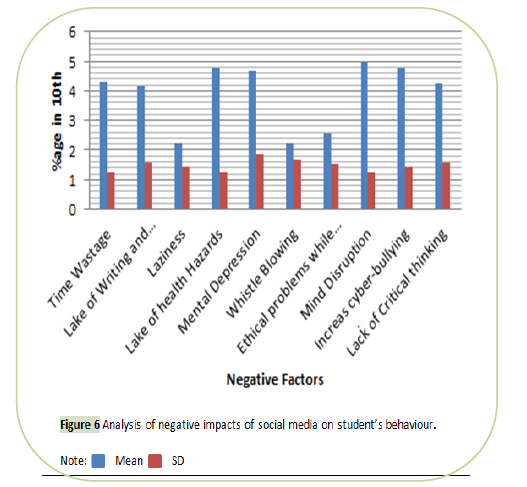
S.no |
Positive Factor | Parents | Teachers | PG Stud ents | F Values |
|---|---|---|---|---|---|
| 1 | PF01 | 3.811 | 3.223 | 4.221 | 4.506 |
| 2 | PF02 | 2.945 | 2.484 | 3.453 | 3.123 |
| 3 | PF03 | 4.555 | 3.555 | 2.568 | 5.145 |
| 4 | PF04 | 3.562 | 4.568 | 4.449 | 6.123 |
| 5 | PF05 | 3.222 | 3.111 | 4.561 | 4.235 |
| 6 | PF06 | 4.758 | 2.756 | 3.692 | 4.562 |
| 7 | PF07 | 4.523 | 3.023 | 2.568 | 4.123 |
| 8 | PF08 | 4.559 | 4.252 | 4.231 | 6.543 |
| 9 | PF09 | 2.521 | 3.251 | 2.961 | 3.562 |
| 10 | PF10 | 3.332 | 4.337 | 6.552 | 6.542 |
Table 4. Positive factors among groups: Parents, teachers and PG students with mean and F-values.
Based upon the reviews and comments, the negative factors among the groups of parents, teachers and PG students after performing the ANOVA test. The obtained results are showing the variance in three different groups with little differences in all categories. While the F values has also been shown in the last column of the table, defining the negative impact of the social media through ANOVA test. Ten different negative factors as discussed above have been selected for the test and after getting the results lie between 2.0 to 6.5 in different categories. While the range of F value is in between 3.5 to 6.5 respectively showing the efficiency of the test performed on the negative factors (Table 5).
| S. No. | Negative Factor | Parents | Teachers | PG Students | F Value |
|---|---|---|---|---|---|
| 1 | NF01 | 3.841 | 3.226 | 4.221 | 5.231 |
| 2 | NF02 | 2.452 | 2.484 | 3.452 | 4.223 |
| 3 | NF03 | 4.551 | 3.551 | 2.565 | 4.125 |
| 4 | NF04 | 3.562 | 4.562 | 4.443 | 5.006 |
| 5 | NF05 | 3.223 | 3.118 | 4.564 | 4.231 |
| 6 | NF06 | 4.751 | 2.755 | 3.699 | 4.125 |
| 7 | NF07 | 4.525 | 3.024 | 2.564 | 3.562 |
| 8 | NF08 | 4.551 | 4.258 | 4.236 | 6.523 |
| 9 | NF09 | 2.568 | 3.252 | 2.962 | 4.231 |
| 10 | NF10 | 3.334 | 4.333 | 6.551 | 6.541 |
Table 5. Negative factors among groups: Parents, teachers and PG students with mean and F-values.
Examining the using pattern of students social networking, particularly on social media, the reason of usage and how they relate with each other on website, how much time they spent by using social media, accompanying with the drawbacks and benefits of using it and what are the impacts of using is also encompassed in this study. The graduate students are more prone to use social media than other students are also pointed out in population data. This research discloses that many respondents are using social media for distributing educational and social information and it is the part of their daily experiences for persisting linked with their friends, plus job purposes, sending birthday greetings and entertainment etc.
The points which are established by this study that most of the respondents also access social media for sharing personal information such as name, picture, birthday, gender, email, phone number, high school, college, university. In addition, religion, country, welfare, political view and other statuses are also shared etc. In the contemporary age, communication systems of the past are altering step by step recommended by this study. Many users spent their time on social media and span of activities is diverse. They can alter, by using social media, their personal, familial, social and career, plus study life, etc. There is a severe alter is happened in whole everyday life of the students as per this study.
For using social media, students responded an open-ended question about their causes as the data depicts. Most of the respondents as per data shows that using social media for getting information, entertainment and communication and educational reasons. As the graphical representation shows that according to parents, their children spend most of their time in communicating with friends and others is around 78%, while the thinking of the teachers is same in this scenario showing with the percentage of 68. According to the PG students, most of the time of their siblings has been used by the Facebook for study purpose and is around 68% and so for the other activities (Figure 7).
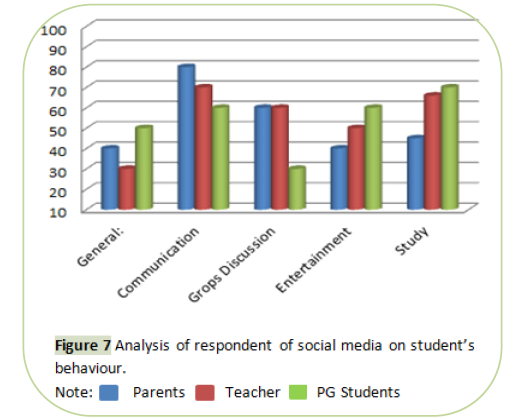
The analysis of usage of social media has been shown for the behaviors of students, whether it’s moderate, average, slight, very less or casual. It has been observed that students are with friends and some are for educational reasons, some are receiving information about the present world according to their parents, teachers and siblings who are also PG students. Graphical representation shows the percentage of using social media by students for general, communication, group discussion, entertainment and study purpose. Results proved that according to parents, teachers and siblings, the time mostly spend by students on social media is for communication and not for the other activities. Hence it has been depicted that social media is more or less beneficial for communication with others instead of study purpose (Figure 8).
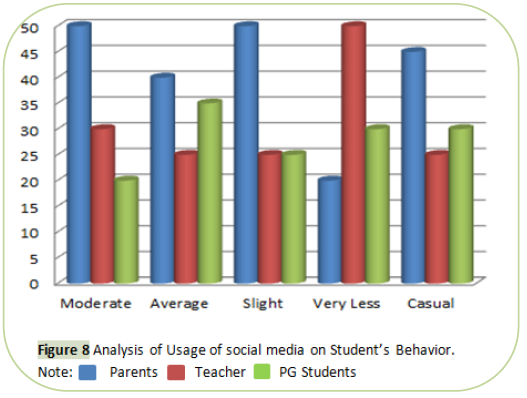
As per this study, most of the student’s association with social media is for academic purposes. Moreover, social media is also used for various reasons such as communicating misinformation, fraud, strange presentation and copy of the statements of people to create misunderstandings between users and fraud. These kinds of patterns influence the students and distract their concentration from academic perspectives to others negatively. The analysis of the various negative factors in the light of reviews posted by the parents, teachers and the PG students. The NF05 has the most effect according to the parents i.e. 54% while NF04 has the least effect on the student’s behavior which is 22%. According to the teachers NF09 has the highest effect which is 50%. On the other hand, NF06 and NF07 have the least effect which is 20%. NF07 has the highest effect according to the PG students while NOF08 has the least i.e. 19% respondents have reasonable effects by using social media, while 17% respondents mentioned very much effect, 19% slight effects, 13% much effect and 7% very slight effects by using social media on their daily usage (Figure 9).
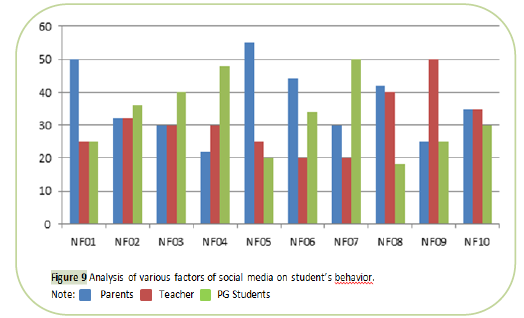
Based upon the data of population, this study provides the relevant literature by examining usage of social media. Moreover, this study claimed that it has a novel involvement because instead of traditional survey and questioner we have collected the open minded opinions of people about their kids regarding the use of social media and its impact on their educational life. It is concluded that union of the social media sites to communicate with friends, family and strangers, social media is spreading across the world as an increasing number of teenagers, student communities and others using it frequently and have the positive and negative factors involved impacting their career.
This study can be observed as a deep research about social media, as it is not an outdated medium of communication in the world. To discover the using practices of social media it’s just an attempt, based on the user’s data. Therefore, a lot of things have been explored and lot of scope is there to continue further research about social media, as it is a trendy medium. Nevertheless, some recommendations for more research about social media based on this study are including as instead of traditional method of data collection like survey and questionnaires which is time taking and difficult to conduct, it is recommended to analyze the public opinion that is openly available on social media forums. This research has been performed to determine the impacts of social media on students behavior that highlights the pros and cons of different factors on the life of student, it is recommended that the proposed study can further be enhance for other factors like promoting social drive on social media.
Indexed at, Google Scholar, Crossref
Indexed at, Google Scholar, Crossref
Indexed at, Google Scholar, Crossref
Indexed at, Google Scholar, Crossref
Indexed at, Google Scholar, Crossref
Copyright © 2025 Global Media Journal, All Rights Reserved